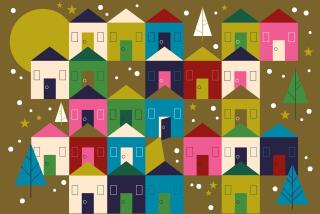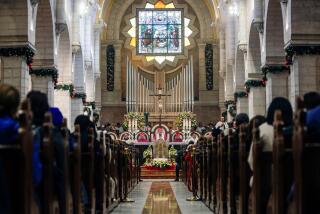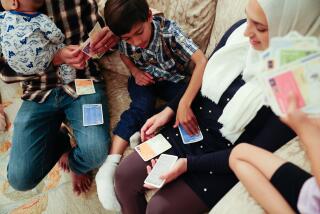Respite in a time of revelry
- Share via
WASHINGTON — They sang “It Came Upon a Midnight Clear,” lighted Advent candles and listened to St. Luke’s story about the birth of Jesus. But the 20 Presbyterians who gathered recently for “a different service of worship for Christmas” also recalled lost loved ones, the trauma of losing a job and the pain of poor health.
“Perhaps the empty chair at the table is too much to bear ... perhaps the illness has just taken too much of a toll on your body
The worshipers then rose one by one, took fire from the Advent wreath to light their own candles and placed them upright in a box of sand. As the tiny quilt of flames formed on the table, a deep silence, broken occasionally by soft sobbing, filled the small chapel.
The service at Little Falls Presbyterian Church, where Hendricks is associate pastor, is part of a spreading Christmas tradition in Protestant churches. More quiet and reflective than the traditional liturgies of Christmas Day or Christmas Eve, these so-called “Blue Christmas” services are for people often overlooked at this time of year: those who just can’t get into the merriment of the season for one reason or another.
Whether it is the first Christmas after the death of a beloved spouse, a recent divorce, a diagnosis of cancer, deep family rifts or the deployment of a loved one to the Middle East, many people find the holidays a time of distress. Blue Christmas services are intended to acknowledge that sadness and to offer comfort.
“My grandfather died in May, and this will be the first Christmas without him,” said a tearful Carlin Schwartz, 24, an Arlington County, Va., schoolteacher who attended the Little Falls service. “I thought it would be easier to do all the other Christmas stuff if I could get the sadness part out of the way first.”
Others say they are drawn to such services because they are overwhelmed by holiday stress and fatigue, or they are alienated by the commercialization of the season. “I came because it’s a wonderful relief from all the glitter and turmoil that’s going on now as we come into the last week before Christmas,” said Ann Potter, 66, a retired school librarian who had spent the day gift-shopping.
The origins of Blue Christmas services are not clear. Some pastors say they’ve been holding them for more than a decade. But they seem to have gained steam after 1996, when a prototype liturgy for such services was included in “Whole People of God,” a Sunday school curriculum used by many Protestant churches in the United States and Canada.
The Rev. Bass Mitchell, a United Methodist pastor in Hot Springs, Va., believes the name may have been inspired by the song “Blue Christmas,” made famous by Elvis Presley.
Many churches, including Little Falls in Arlington, prefer to call them “Longest Night” services because the gatherings are usually held on or near Dec. 21, the winter solstice.
Along with Biblical readings and songs stressing God’s comfort, the services usually involve lighting candles to mark an important event or the loss of a loved one. Rituals that symbolize hope and encouragement for the participants are another feature.
At Community of Faith, a United Methodist church in Herndon, Va., people were invited at a service last Monday to write their reasons for being sad on a piece of paper.
They then placed the notes into a large glass bowl of water, representing the tears they had shed, “and the words on paper disappeared,” said church member Nancy Webster. “It was symbolic that the water, the tears that had been shed, were cleansing.”
Mental-health experts say Blue Christmas services meet a widespread need because people’s high expectations for happy times during Christmas often are not met, worsening whatever depression or sadness they were already experiencing.
“Our call volume goes up a lot,” said Mary Azoy, director of training and community crisis response for CrisisLink, an Arlington-based association of hotlines. “I’m delighted to know that some of the churches are recognizing the part of us that wants to be quiet rather than going out and spending $300 on gifts that nobody wants.”
The Church of the Good Shepherd, also United Methodist, in Vienna, Va., held its first Longest Night service Saturday as an occasion “to find the meaning and truth behind the bows and packages.”
Participants holding lighted candles approached the communion rail one by one and were directed to one side or the other, depending on whether they wanted to pray privately or with others. The Rev. James Noland, Good Shepherd’s pastor, said the idea was to give participants a comfortable choice.
Afterward, the candles were placed on the altar. The service, which was open to the public, was not just for the grief-stricken, Noland added. “To put it colloquially,” he said, “it’s for anybody with the holiday blues.”


